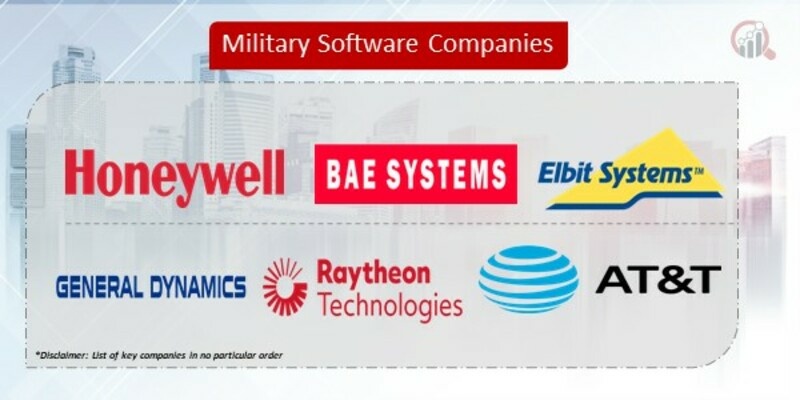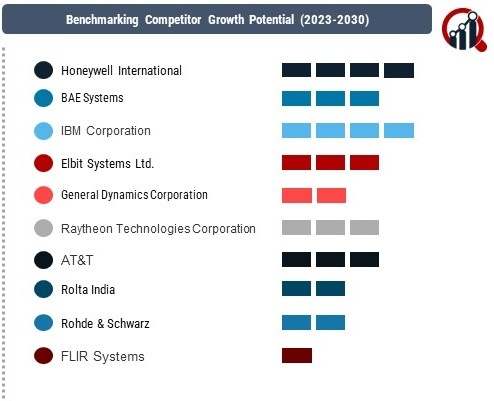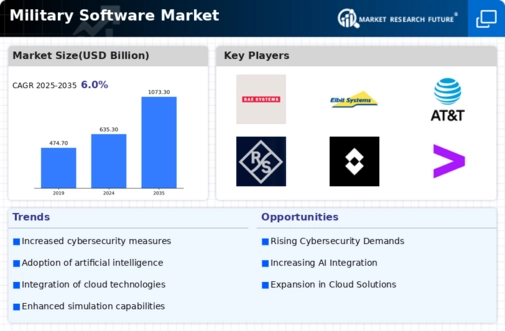Top Industry Leaders in the Military Software Market

At The Forefront Of The Military Software Market Are Major Players
Honeywell International Inc in the US
BAE Systems in the UK
IBM Corporation in the US
Elbit Systems Ltd. In Israel
General Dynamics Corporation in the US
Raytheon Technologies Corporation in the US
AT&T in the US
Rolta India in India
Rohde & Schwarz in Germany
FLIR Systems in the US
Accenture in Ireland
Strategies Adopted: In the intensely competitive Military Software Market, key players are adopting multifaceted strategies to maintain their dominance and expand their market share. One prominent strategy involves focusing on research and development to deliver cutting-edge software solutions. Lockheed Martin, for example, has consistently invested in developing advanced command and control systems, cybersecurity solutions, and mission planning software to meet the evolving needs of modern defense operations.
Another prevalent strategy revolves around strategic partnerships and collaborations. Northrop Grumman, for instance, has forged alliances with leading technology companies to harness synergies in developing integrated software solutions. These partnerships not only enhance product offerings but also facilitate global market penetration.
Moreover, mergers and acquisitions have become a common tactic to strengthen market position and broaden capabilities. BAE Systems' acquisition of smaller software firms with niche expertise exemplifies the industry trend of consolidation. By integrating specialized technologies, major players seek to create comprehensive software suites that address diverse military requirements.
Factors for Market Share Analysis: Several factors contribute to the market share dynamics in the Military Software Market. Technological prowess and innovation play a pivotal role, as defense forces prioritize software solutions that provide a technological edge. Market penetration, global reach, and the ability to offer tailored solutions for diverse defense applications also influence market share.
Furthermore, compliance with stringent security standards and certifications is a key determinant. Given the sensitive nature of military operations, software providers must adhere to rigorous security protocols. Companies that consistently meet and exceed these standards gain a competitive advantage, enhancing their market share.
New and Emerging Companies: The Military Software Market is witnessing the emergence of innovative startups that bring agility, niche expertise, and disruptive technologies to the industry. Companies like Palantir Technologies and Anduril Industries have gained traction by focusing on data analytics, artificial intelligence, and autonomous systems for military applications.
These new entrants often challenge established players by introducing novel approaches to problem-solving. Palantir, for instance, leverages its data integration and analytics capabilities to offer comprehensive solutions for military intelligence and decision-making. The nimbleness of these emerging companies allows them to address evolving challenges in military operations swiftly.
Industry News: Recent industry news highlights the ongoing developments and strategic moves within the Military Software Market. One notable trend is the increasing emphasis on cybersecurity solutions to safeguard military systems from cyber threats. With the rising frequency and sophistication of cyber-attacks, software providers are investing heavily in developing robust cybersecurity measures.
Additionally, news surrounding international collaborations and joint ventures reflects the global nature of the Military Software Market. Cross-border partnerships are becoming more common as nations seek to pool resources and expertise to address shared defense challenges. These collaborations not only foster technological advancements but also create new opportunities for market expansion.
Current Company Investment Trends: Investment trends in the Military Software Market underscore the industry's commitment to innovation and growth. Significant investments are flowing into research and development, with a focus on artificial intelligence, machine learning, and advanced analytics. Companies recognize the need to stay ahead in technological advancements to meet the evolving demands of defense forces.
Moreover, there is a noticeable trend of investment in dual-use technologies that have applications both in military and civilian domains. This approach not only diversifies revenue streams but also aligns with the increasing interdependence of military and civilian technologies.
Overall Competitive Scenario: The overall competitive scenario in the Military Software Market is characterized by a delicate balance between established industry leaders and nimble, innovative newcomers. As technological advancements continue to reshape the defense landscape, companies that can adapt quickly, foster strategic partnerships, and deliver comprehensive, secure, and scalable software solutions will thrive.
The intersection of artificial intelligence, cybersecurity, and data analytics is emerging as a focal point for competitive differentiation. Companies that can seamlessly integrate these technologies into their software offerings will likely lead the market in providing intelligent, secure, and agile solutions for modern defense applications.
In conclusion, the Military Software Market is a vibrant ecosystem where traditional giants, new entrants, and disruptive technologies converge. The strategies adopted, market share dynamics, and investment trends collectively shape a landscape that is not only competitive but also crucial for global defense capabilities. As nations continue to invest in modernizing their armed forces, the evolution of the Military Software Market will undoubtedly remain a key determinant of military preparedness in the 21st century.
Recent News :
BAE Systems : are among the key players dominating the landscape. These industry giants boast extensive experience, technological expertise, and global reach, positioning them as leaders in providing sophisticated software solutions for military applications.
L3Harris Technologies:
- Acquired Acuity Logic, expanding their portfolio in artificial intelligence and data analytics for situational awareness and decision support.
- Developing cyber resilience solutions for protecting military networks from increasingly sophisticated attacks.
- Focusing on interoperability and collaboration between different branches of the armed forces through software integration.
Microsoft:
- Awarded a $10 billion contract for the Joint All-Domain Command and Control (JADC2) program, aiming to create a unified data platform for the US military.
- Partnering with other technology companies to provide cloud-based solutions for AI, machine learning, and augmented reality applications in the military.
- Emphasizing cybersecurity and data privacy within their military software offerings.
Palantir Technologies:
- Expanding their footprint in intelligence analysis and data fusion for enhanced battlefield awareness and decision-making.
- Developing predictive analytics tools to anticipate enemy movements and potential threats.
- Focusing on open-source intelligence (OSINT) integration and social media analysis capabilities.










